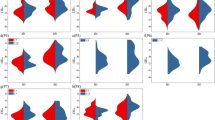Summary
Different wheat genotypes (T. aestivum) were crossed with rye to ascertain the site or sites of manifestation of the crossability genes, Kr 1 and Kr 2. By using fluorescence microscopy, it was found that the order of increasing proportion of wheat micropyles containing pollen tubes is strongly correlated with the levels of crossability with rye. High crossable genotypes have more micropyles containing pollen tubes than those of the low crossable ones. Most of the inhibition or retardation of pollen tubes occurred between the style base and top of the embryo sac, expecially with the low crossable genotypes where both Kr-genes are present. The results also indicate that Kr 1 is a greater inhibitor than Kr 2. Seed set is also highly correlated with the number or proportion of micropyles having pollen tubes. Alternate pollinations seem to support the view that rye pollen tubes do not reach the micropyles of the low crossable genotypes, and hence when repollinated with wheat selfed seeds are produced.
Similar content being viewed by others
References
Bennett, M. D., M. K. Rao, J. B. Smith & M. W. Bayliss, 1973. Cell development in the anther, the ovule, and the young seed of Triticum aestivum L. var. Chinese Spring. Phil. Trans. R. Soc. London, B. Biol. Sci. 266: 39–81.
Jalani, B. S., 1973. Crossability, cytogenetics and fertility in Gramineae. Ph.D. Thesis, University of Reading, England.
Jalani, B. S. & J. P. Moss, 1980. The site of action of the crossability genes (Kr 1, Kr 2) between Triticum and Secale. I. Pollen germination, pollen tube growth and number of pollen tubes. Euphytica 29: 571–579.
Lange, W. & B. Wojciechowska, 1976. The crossing of common wheat (Triticum aestivum L.) and cultivated rye (Secale cereale L.) I. Crossability, pollen grain germination and pollen tube growth. Euphytica 25: 609–620.
Lein, A., 1943. Die genetische Grundlage der Kreuzbarket zwischen Weizen und Roggen. Z. induk. Abstamm.-u. Vereblehre. 81: 28–61.
Meyer, H., 1971. Blütenbiologische Untersuchungen bei Getreidekreuzungen. I. Mitt. Das Wachstum von Roggen-und Weizenpollenschläuchen in der Weizennarbe und die Entwicklung des Fruchtknotens bis 48 Stunden nach der Bestäubung. Arch. Züchtungsforch. 1: 171–183.
Riley, R. & V. Chapman, 1967. The inheritance in wheat of crossability with rye Genet. Res. 9: 259–267.
Tozu, T., 1965. Crossability between wheat and rye. Seiken Zihô 18: 33–38.
Zeven, A. C. & C. Van Heemert, 1970. Germination of pollen of weed rye (Secale segetale L.) on wheat (Triticum aestivum L.) stigmas and the growth of the pollen tubes. Euphytica 19: 175–179.
Author information
Authors and Affiliations
Rights and permissions
About this article
Cite this article
Jalani, B.S., Moss, J.P. The site of action of crossability genes (Kr 1, Kr 2) between Triticum and Secale. II. Proportion of pistils containing pollen tubes and effects of alternate pollination on seed set. Euphytica 30, 105–112 (1981). https://doi.org/10.1007/BF00033665
Received:
Issue Date:
DOI: https://doi.org/10.1007/BF00033665




